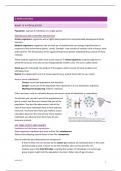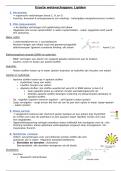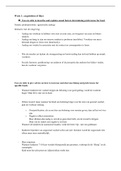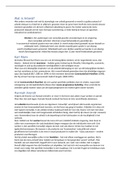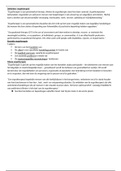3 POPULATIONS
WHAT IS A POPULATION
Population: a group of individuals of a single species.
INDIVIDUALS AND COUNTING INDIVIDUALS
Unitary organisms: organisms with a highly determinate form and predictable development (birds,
humans)
Modular organisms: organisms that are built up of modules that can change shape/function in
response to the environment (plants, corals). Example: tree consists of modules such as leaves, buds
and branches. The final product of the zygote (the genet or genetic individual) thus consists of many
modules.
These modular organisms often have clonal systems à Clonal organisms: modular organism in
which the structure units also survive independently of other units. The unit is called ramet.
Genet (genetic individual): the product of the zygote, which consists of many modules and
ultimately form.
Ramet: the independent unit of a clonal organism (e.g. a plant shoot with its own roots)
How to count individuals?
- Census: count total population; not statistical
- Sample: count part of the population that represents it; it’s an estimation; statistical
- Marking and recapturing: indirect; statistical
Often we have to rely on estimates because we cannot count all individuals in a population.
To estimate you can catch part of the population and
give it a mark, and then you release that part of the
population. You start the observation: look at the
ratio of how many individuals have a mark and how
many not. You know how many you marked, so you
calculation based on the ratio of how many marked
individuals you observe times how many do you
know you marked.
LIFE TABLE (STATIC AND COHORT)
Population and Life history: reproduction
Some organisms reproduce just once in their life: semelparous.
Others have offspring several times in their life: iteroparous.
How to make the best observation for iteroparous?
- If there is time, we can monitor all the cohort (generation): all individuals born in the same
period (usually a year). It easier to see the mortality, who survive and who not.
- Another way is the static life table: counting the number of individuals of a certain age
group to gain insight into the population structure. Better idea of age structure.
Lecture 3
1
, SURVIVING CURVES
Ecology is also about finding general rules. To talk about how populations grow there is a general
rule for survival. There are three time of survival curves:
Type I: organisms with high survival at young age and high
mortally risk later in life (like humans).
Suitable for K-species ® K is carrying capacity; these
population often live at his maximum number of individuals
of that specific environment.
Type II: organisms with steadily decreasing survival and
constant mortality risk. Risk of mortality is constant,
Type III: organisms with a high mortality at young age
DISPERSAL AND MIGRATION
There are two types of movement of individuals:
• Dispersal when organisms are doing unfocused movements patterns, they don’t have a
reason to move but do it randomly. Example is dandelion, the seeds go where the wind
takes them, no control because they are not actively moving.
Dispersal is age dependent: dispersal depending on the age of the organism (the mother
plant is not going to move; young animals often colonise new areas.
It’s also density dependent: dispersal due to an increase in local population density.
Dispersal: the wolf return to the NL.
• Migration is focused and often massive, there is a reason for moving, like searching for food
or a better area. The benefit of migration is to escape from unfavourable living conditions,
even if takes energy and a higher risk of mortality. We can distinguish patterns in migration:
Repeated migration, when there is a multiple times movement back and forth in different
part of the environment (birds). There are three types: daily migration, tidal migration,
seasonal migration.
Migration with return, birth in habitat A and reaching adulthood in habitat B, and migrating
back to habitat A for reproduction (salmon).
One-time migration is one way only, the migration is in one single direction (butterflies,
locusts).
POPULATION GROWTH AND INSTRASPECIFIC COMPETITION
The simplest method to calculate population growth is with exponential growth:
dN/dt = r *N ® the change of number of individuals is defined by an intrinsic value of the species
r, how many offspring it makes and how quickly. When resources are unlimited.
But in nature there is a break of population growth, that is the result of competition for resources:
intraspecific competition, which means that individuals of the same species compete for food,
because the environment has a maximum of this resource, so there is a maximum of individual that
can be sustained. This is the carrying capacity K.
We can calculate population growth with intraspecific competition with logistic growth.
Lecture 3
2
WHAT IS A POPULATION
Population: a group of individuals of a single species.
INDIVIDUALS AND COUNTING INDIVIDUALS
Unitary organisms: organisms with a highly determinate form and predictable development (birds,
humans)
Modular organisms: organisms that are built up of modules that can change shape/function in
response to the environment (plants, corals). Example: tree consists of modules such as leaves, buds
and branches. The final product of the zygote (the genet or genetic individual) thus consists of many
modules.
These modular organisms often have clonal systems à Clonal organisms: modular organism in
which the structure units also survive independently of other units. The unit is called ramet.
Genet (genetic individual): the product of the zygote, which consists of many modules and
ultimately form.
Ramet: the independent unit of a clonal organism (e.g. a plant shoot with its own roots)
How to count individuals?
- Census: count total population; not statistical
- Sample: count part of the population that represents it; it’s an estimation; statistical
- Marking and recapturing: indirect; statistical
Often we have to rely on estimates because we cannot count all individuals in a population.
To estimate you can catch part of the population and
give it a mark, and then you release that part of the
population. You start the observation: look at the
ratio of how many individuals have a mark and how
many not. You know how many you marked, so you
calculation based on the ratio of how many marked
individuals you observe times how many do you
know you marked.
LIFE TABLE (STATIC AND COHORT)
Population and Life history: reproduction
Some organisms reproduce just once in their life: semelparous.
Others have offspring several times in their life: iteroparous.
How to make the best observation for iteroparous?
- If there is time, we can monitor all the cohort (generation): all individuals born in the same
period (usually a year). It easier to see the mortality, who survive and who not.
- Another way is the static life table: counting the number of individuals of a certain age
group to gain insight into the population structure. Better idea of age structure.
Lecture 3
1
, SURVIVING CURVES
Ecology is also about finding general rules. To talk about how populations grow there is a general
rule for survival. There are three time of survival curves:
Type I: organisms with high survival at young age and high
mortally risk later in life (like humans).
Suitable for K-species ® K is carrying capacity; these
population often live at his maximum number of individuals
of that specific environment.
Type II: organisms with steadily decreasing survival and
constant mortality risk. Risk of mortality is constant,
Type III: organisms with a high mortality at young age
DISPERSAL AND MIGRATION
There are two types of movement of individuals:
• Dispersal when organisms are doing unfocused movements patterns, they don’t have a
reason to move but do it randomly. Example is dandelion, the seeds go where the wind
takes them, no control because they are not actively moving.
Dispersal is age dependent: dispersal depending on the age of the organism (the mother
plant is not going to move; young animals often colonise new areas.
It’s also density dependent: dispersal due to an increase in local population density.
Dispersal: the wolf return to the NL.
• Migration is focused and often massive, there is a reason for moving, like searching for food
or a better area. The benefit of migration is to escape from unfavourable living conditions,
even if takes energy and a higher risk of mortality. We can distinguish patterns in migration:
Repeated migration, when there is a multiple times movement back and forth in different
part of the environment (birds). There are three types: daily migration, tidal migration,
seasonal migration.
Migration with return, birth in habitat A and reaching adulthood in habitat B, and migrating
back to habitat A for reproduction (salmon).
One-time migration is one way only, the migration is in one single direction (butterflies,
locusts).
POPULATION GROWTH AND INSTRASPECIFIC COMPETITION
The simplest method to calculate population growth is with exponential growth:
dN/dt = r *N ® the change of number of individuals is defined by an intrinsic value of the species
r, how many offspring it makes and how quickly. When resources are unlimited.
But in nature there is a break of population growth, that is the result of competition for resources:
intraspecific competition, which means that individuals of the same species compete for food,
because the environment has a maximum of this resource, so there is a maximum of individual that
can be sustained. This is the carrying capacity K.
We can calculate population growth with intraspecific competition with logistic growth.
Lecture 3
2

